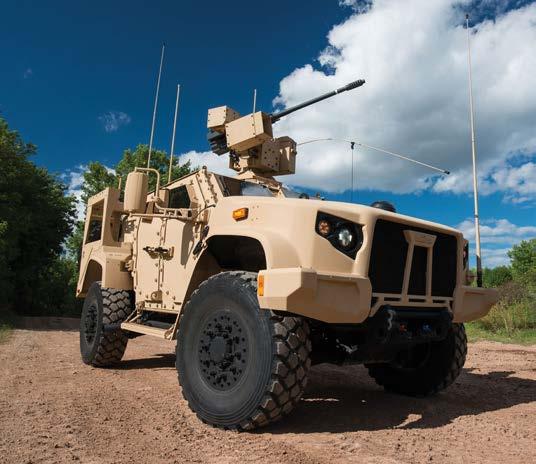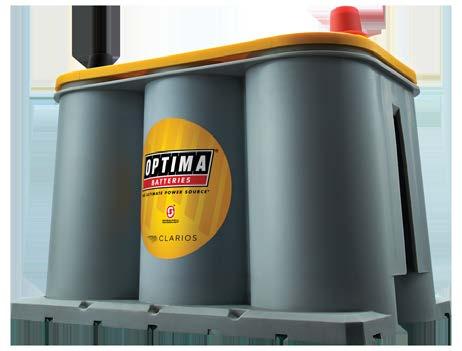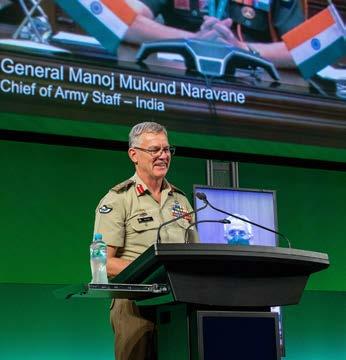
9 minute read
Re-imagining the future
The Chief of Army Symposium was a showcase of innovation and new ideas.
Army highlighted the importance of regional engagement and industry collaboration during the recent Chief of Army Symposium 2021, held at the Brisbane Convention Centre from April 19 to 20.
Advertisement
The CA Symposium brought together Defence, international partners, science and technology experts, academia and industry to discuss the issues facing Army and the region in the next decade.
“Your ideas and perspectives help us think beyond where we are today and help us imagine or, indeed re-imagine, the future,” CALt-Gen Rick Burr said.
A highlight of the symposium was the panel discussion regarding regional challenges where the CA was joined remotely by his counterparts, the CAs of India, Indonesia, Japan and Singapore.
“Talking about challenges and opportunities among our regional military leaders was very powerful,” Lt-Gen Burr said.
Lt-Gen Burr said it was a great example of the ways in which Army has adapted to new ways of collaborating and contributing to an Indo-Pacific that is stable and prosperous.
“They shared their perspectives on the strategic challenges that we are confronting and how we might get after them,” he said.
The Army’s support to Australianled technology, partnerships with academia and industry, and innovation was also bolstered by the Army Innovation Day, Army Robotics Expo and the Quantum Technology Challenge.
Lt-Gen Burr said the two-day event has given ADF personnel, academia and industry partners the chance to get hands-on with the latest technology and innovation to support our “Future Ready” Army.
The Army Innovation Day had more than 21 Australian industry partners pitching ideas to meet Army’s commitment to energy and environmental resilience.
“In particular, on Innovation Day there were examples of investing with small companies who have great innovative ideas, who we’ve worked with to develop their ideas and turn them into products to integrate with capabilities that we’re using in the Army,” Lt-Gen Burr said.
“It was really exciting. There was a real buzz in the room and in the exhibition hall where people were displaying their ideas to us.”
The Army Robotics Expo featured displays and demonstrations from more than 55 Australian owned and led businesses including optionally crewed vehicles, aerial systems and emerging soldier technology.
“I am proud to support the exploration of disruptive technologies,” Lt-Gen Burr said.
“It highlights our commitment to working with some of the best and brightest to learn, understand, prototype and experiment with potential capabilities for the Army.”
The Quantum Technology Challenge (QTC 2021) provided a forum for Australian academic and industry organisations to pitch their ideas to
Above: Chief of Army, Lieutenant General Rick Burr, AO, DSC, MVO gives his opening address. Opposite: The Ghost Robotics quadruped robot is presented at the Robotics Expo and Quantum Technology Challenge.
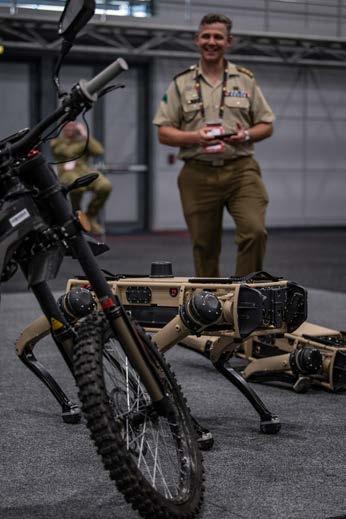
Army personnel on how quantum technology can result in military advantage for the Army.
Head of Land Capability Maj-Gen Simon Stuart launched Army’s Quantum Technology Roadmap at QTC 2021, and said the event was the perfect chance to showcase Australian technology and its importance to Army
“We will see a global increase in the use of these technologies in the future, and they will offer significant military advantage to early adopters,” Maj-Gen Stuart said.
The symposium also brought together junior and senior enlisted from across Army in the Junior Leaders’ Forum and Senior Enlisted Conference to discuss the behaviours so vital to successful engagement in our region.
“People who are enabled to operate at their peak are the foundation of our capability and credibility as a combat force,” Lt-Gen Burr said.
“Our success will depend on teams who are well led and who are accountable for what they do.”
This year’s symposium was the first to be held since 2018, and there are plans for another event next year.
Following the autonomous leader
Future convoy commanders might not have any troops to worry about with the rapid development of autonomous systems that can be fitted to almost any vehicle.
A collaboration between Deakin University and Army has produced an autonomous leader/follower vehicle system that could result in unmanned convoys of today’s vehicles.
They are fitted with actuations of their controls, along with fused lidar, radar, ultrasound and 3D-Z cameras, then programmed to follow a lead vehicle.
That leader could be driven by a solder behind the wheel, back on base from a computer or automatically follow a set of GPS waypoints – perhaps bringing an end to the days of formal convoy orders.
Project leader Prof Saeid Nahavandi of Deakin University said Army’s remit was to remove the danger and workload from soldiers, while keeping humans “on” the loop, rather than “in” the loop.
“We take away all of the mundane tasks and danger, but a human is always in control, making the decisions,” Prof Nahavandi said.
Follower vehicles can also be programmed to trail anything from a drone to a walking person.
The system operates via 4G, GPS, satellite and other radio frequencies and was fitted to a 40M MAN truck for the first public demonstration at the Army Robotics Expo, but it can be fitted to any vehicle.
“My project was supposed to be for outdoors, but I was asked to do the demonstration indoors, without GPS. But we did it. It works in a GPSdenied environment autonomously, which we have tested previously,” Prof Nahavandi said.
The first variant with a large battery and controller was the size of a fridge,
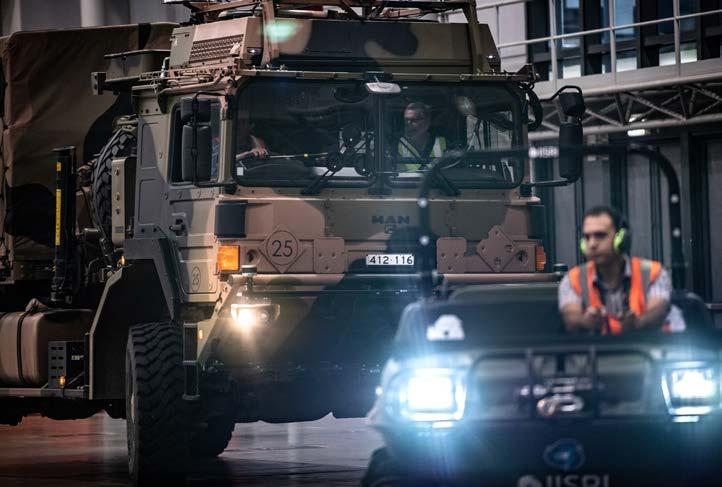
Chief of Army Lieutenant General Rick Burr AO, DSC, MVO, rides as passenger in an autonomous Australian Army 40M Truck at the Robotics Expo and Quantum Technology Challenge at the Brisbane Convention and Exhibition Centre. Defence image.
but a second generation uses vehicle power and fits inside a Pelican case.
All taking about two hours to set
up.
“Final size will depend on the processing power,” Prof Nahavandi said.
“Mobile phones these days have so much capability that an old space shuttle didn’t.”
Follower vehicles also instantaneously respond to changes from the leader in real-time, meaning they can simultaneously reverse into parking bays.
If vehicles are cut off or a leader destroyed, another vehicle can become the leader or a human controller can designate one remotely.
This means the new leader can lead remaining vehicles around the obstacle.
Prof Nahavandi’s team did perform some tweaks to refine performance out field. “In those conditions we’ve trialed switching off some of the sensors to ignore leaves and small branches,” he said.
Work on the project began in December 2018 and Prof Nahavandi said operational use could be only months away.
“The system is functional, we’ve demonstrated it, from here it’s about exercising it on bigger vehicles,” he said.
The system currently supports four follower vehicles, but the team are looking to increase this to eight.
They would then refine the technology to optimise for heavy rain, snow and dust. Prof Nahavandi believed that might take another year.
The team can also include a secure, mobile cloud at the back of a vehicle to support additional Ai processing out field for requirements beyond autonomous vehicles.
Army News
Optima Powering up at Land Forces
R&J Batteries and Clarios are teaming up to bring Land Forces a stand full of the Ultimate Power Source – Optima Batteries®. Set to land at the Brisbane Convention centre between the 1st and 3rd of June, the Land Forces International Land Defence Exposition will be showcasing the best equipment and technology for the defence industry. Stand GL4 in the great hall will be where you can find the R&J Batteries team with answers to why Optima is the approved battery for the U.S. Military.
Optima Batteries are built to be the ultimate power source for extreme applications. The range features a series of colour-coded high-performance AGM batteries known as Red Top®, Yellow Top® and Blue Top®. The Red Top battery is designed for automotive applications, the Yellow Top battery for deep-cycle applications while the Blue Top battery is ideal for marine applications. Each battery is structurally designed to provide the application with the most power for the longest period of time.
The key feature of Optima Batteries, and why they have been chosen as the approved battery for the U.S. Military, is their unique Spiralcell Technology®. This technology is based on a series of individual cells composed of two pure (99.99%) lead plates, coated in a precise coating of lead oxide and spiral wound into a coil rather than a row. This innovation in battery design provides a number of benefits such as 15x more vibration-resistance, up to 3x longer life and up to 5x more cycle life compared to conventional leadacid batteries. Optima’s Spiralcell Technology provides higher starting power and quicker recharge compared to other flat plate batteries in the market. The unique cell design also enables it to hold its shape even under harsh weather conditions and corrosion which conventional batteries are not built to withstand.
Optima batteries are a premium choice for vehicles with large power demands or for customers who seek greater reliability and longer life expectancy from their batteries. Due to the in-built Spiralcell Technology, Optima Yellow Top batteries have both deep-cycle and starting capabilities. This makes Optima Yellow Top batteries an ideal choice for extreme applications that have greater demands such as needing to withstand the abuse of 4WD off-roading, cranking out decibels or the ability to withstand harsh environmental conditions. Optima Yellow Top batteries are also suitable for starting applications requiring reliability such as military vehicles, emergency services, road transport and agricultural machinery. Applications with numerous accessories such as running lights, winches, hydraulics or a high-performance stereo/AV system will also benefit from being fitted with an Optima Yellow Top battery.
Recently added to the Yellowtop range is the Optima® H6 battery which is specifically designed to fit more vehicles requiring a DIN fitment (recessed terminals) solution. The internal chemistry of the OPTIMA H6 is perfect for the high-energy and cranking power needed in DIN applications. Built differently to other batteries in the range, the H6 Yellowtop battery features Optima’s exclusive Pureflow Technology™, an amazingly durable, non-spillable,AGM battery featuring flat-plates engineered with 99.99% pure lead, increasing plate count and surface area for maximum power and battery life.
R&J Batteries is one of two approved Optima distributors in Australia and New Zealand. Celebrating 25 years of success, the battery distributor is one of the fastest growing battery companies inAustralasia. With 25 company-owned branches and more than 8,000 distributors in Australia and New Zealand, Optima batteries are within reach at any R&J Batteries location or stockist.
See us at stand GL4 at the Land Forces Expo 1-3rd June or learn more at rjbatt.com.au or by calling your closest R&J Batteries branch on 1300 769 282.
